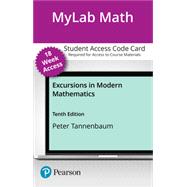For courses in Liberal Arts Mathematics.
This ISBN is for the 18-week MyLab access card. Pearson eText is included.
Discover the power and beauty of math
Excursions in Modern Mathematics by Peter Tannenbaum helps learners develop an appreciation for the aesthetics and applicability of mathematics. Contemporary topics ranging from COVID-19 to election polling demonstrate that math is a usable tool, applicable and interesting for anyone. Refinement and updating of examples and exercises, plus increased resources for both students and instructors, make the 10th Edition a relevant, accessible, and complete program.
Personalize learning with MyLabMath with Pearson eText
This flexible digital platform combines unrivaled content, online assessments, and customizable features to personalize learning and improve results.
Pearson eText is an easy-to-use digital textbook available within MyLab® that lets you read, highlight, and take notes all in one place.
NOTE: Before purchasing, check with your instructor to confirm the correct ISBN. Several versions of the MyLab® and Mastering® platforms exist for each title, and registrations are not transferable. To register for and use MyLab or Mastering, you may also need a Course ID, which your instructor will provide.
Used books, rentals, and purchases made outside of Pearson
If purchasing or renting from companies other than Pearson, the access codes for the MyLab platform may not be included, may be incorrect, or may be previously redeemed. Check with the seller before completing your purchase.











